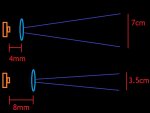- Joined
- Jul 10, 2015
- Messages
- 13,059
- Points
- 113
Thought I would test a G7 against the G8 and a DTR G2 as a reference point then I went ahead and ran a couple different clean new 3 elements, I used a seasoned nubm44.
Note: Even with a large heat sink it's important to adjust the next lens to be tested then let the laser return to room temp before testing, also 3 element lenses are not created equal.
DTR G2 = 6804
DTR G8 = 6249
San G7 = 5896
3 ele #2 = 5361 Half threaded 3 element.
DTR G3 - 5315
3 ele #1 = 5137
8mmFL = 4953 8mm FL ebay lens AR coated 450nm in DTR G2 lens barrel. Tested several times 4.9w each time.
Note: Even with a large heat sink it's important to adjust the next lens to be tested then let the laser return to room temp before testing, also 3 element lenses are not created equal.
DTR G2 = 6804
DTR G8 = 6249
San G7 = 5896
3 ele #2 = 5361 Half threaded 3 element.
DTR G3 - 5315
3 ele #1 = 5137
8mmFL = 4953 8mm FL ebay lens AR coated 450nm in DTR G2 lens barrel. Tested several times 4.9w each time.




